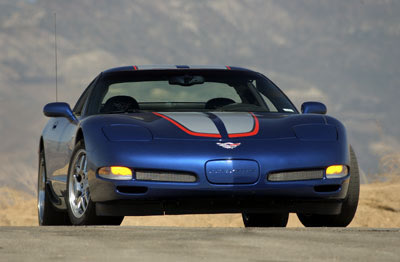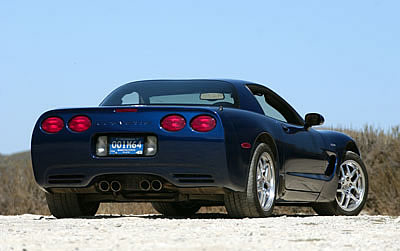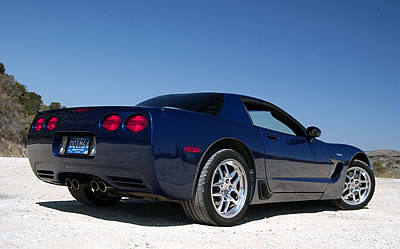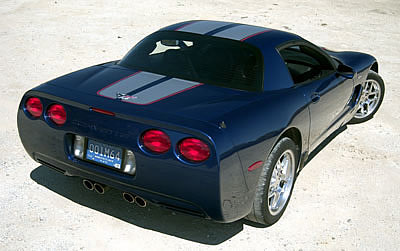We Toast the C5 Corvette's Final Year with a Test of the 2004 Corvette Z06 - Page 3 of 6
by Hib Halverson
text and images ©2004 Hib Halverson
No use without permission
 |
 |
 |
 |
 |
"If you look at the shock's force/velocity curve, we went into the middle velocity range and took a little damping out, added a little bit more on either side of that, in the low-speed and at higher speed."
"Low-speed is body control, high-speed is wheel control and somewhere in between is everything else. If you think of body heave motions-goin' through swells-that's the lowest body speed you have to deal with. Next up, is roll motion, like you'd have in quick transients or crossing surfaces that differ side-to-side-like when you get 'head toss.' Roll velocities are higher than heave velocities because, in addition to spring stiffness, you have stabilizer bar stiffness, so your roll stiffness is higher. It's roll velocity on which we reduced damping. I had too much in that range. We lowered it, there, but overall, we didn't want to lose body control, so we made that back up in the low speed, body heave area and, also, just above the body roll velocity range."
If roll velocities are higher, how can reduced damping make the car handle better? If the car is overdamped in roll; the body reacts quickly to roll events, ride is annoying, the wheels can't follow the road such that they maintain traction and the car will not be as confidence-building or predictable on roads that are rough. The reduction of medium velocity damping allows the body to react a little slower to roll events. Handling improves because grip is more consistent and, of course, ride is nicer. There is a small difference, front to rear, in this reduction of medium velocity damping with the rear getting a slightly greater reduction. This difference is the key enabler of the car's more poised feel during corner entries on "choppy" surfaces which impart medium velocities to the suspension. The improvement was noticeable and contributes to the '04 being the most civilized of Z06's four-year run while still offering the ferocious, at-limit handling for which the car has become famous.
The supension development engineer's vocabulary is full of words quantifying the frequency of ride events. A "choppy" surface is not one causing large, slow suspension movements, such as crossing a dip or a swell, nor does it cause small, rapid movements, such ripple strips on the sides of Interstates or chatter bumps formed in an asphalt surfaces by constant, heavy traffic. Between those two, "choppiness" imparts a medium velocity to the suspension.
The Z06 shock valving has been altered twice: once at the rear for 2002 and again at both ends for 2004. Both times the changes revolved around improving the ride over choppy surfaces. In driving the '04 Z06 Le Mans Collector Edition, the improvement was noticable and contributes to the '04 being the most civilized of the Z06's four-year run while still offering the ferocious, at-limit handling the car has been providing since '01.
Besides the new shocks, there are two other changes. Front, upper control arm bushings now use higher durometer rubber to reduce compliance. This increases front "camber stiffness" under high cornering loads, especially during hard cornering over chatter bumps. The increased camber stiffness makes the front end stick a little better so, to balance the car, a little rear end grip was added by increasing the compliance of the rear stabilizer bar mounts. This had the same effect as a slight reduction in bar diameter but was less costly than tooling-up a new rear bar.
A Z06, by nature rides rather firm. It lacks the isolation and extensive damping of body movement one experiences in Corvette Targas and Convertibles with Magnetic Selective Ride Control but that's by design. Z06 is the extreme enthusaist's Corvette and, for its handling to be true to that label, it needs to ride more firmly. On the other hand, the Z06's ride is not so aggressive it can only live on a racetrack. For that, there is yet a fifth iteration of the C5 suspension tuning, called "T1," a special set of springs, stabilizer bars and shocks intended solely for race track use and available on an aftermarket basis through the GM Performance Parts program.
"It is a total win-win." Neal summarized his team's work, "We think the '04 Z06 handles better. We think it rides better. You can be a lot more aggessive with it on the track.
After a week in which we took to calling this car the "Blue Bullet"; we couldn't agree more.